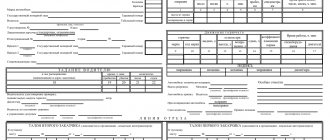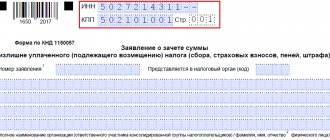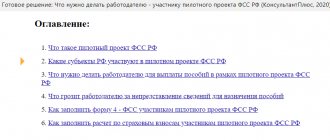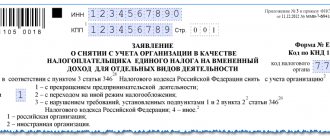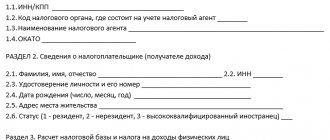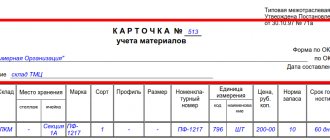Basic rules for issuing an M-17 card
Today there is no single, obligatory sample of a material accounting card, so enterprises and organizations have the opportunity, at their discretion, to develop a document template and use it in their activities (sometimes they do this by ordering a printing house to print their own forms or printing them on a regular printer). But most often, warehouse workers, in the old fashioned way, fill out the previously generally accepted form M-17, which reflects all the necessary information about the supplier, consumer and inventory items.
For each type of product or material, its own accounting card is filled out, which is then necessarily numbered in accordance with the numbering of the warehouse card file. All necessary receipts, consumables and invoices are attached to the card.
The document can be written by hand or filled out on a computer. Moreover, regardless of how the data will be entered into it, it must contain the “living” signature of the storekeeper, as a materially responsible person who is responsible for the safety of the property entrusted to him. It is not necessary to put a stamp on the document, since it relates to the internal document flow of the organization.
Inaccuracies and blots in the materials accounting card should not be allowed, but if some mistake does occur, it is better to fill out a new form, or, as a last resort, carefully cross out the incorrect information and write the correct information above, confirming the correction with the signature of the responsible employee. In the same way, it is unacceptable to draw up a document in pencil - this can only be done with a ballpoint pen.
After the end of the reporting period (usually one month), the completed materials accounting card is first transferred to the enterprise’s accounting department, and then, like other primary documents, to the enterprise’s archive, where it must be stored for at least five years.
How to organize warehouse accounting
First of all, you need to decide who will be responsible for the safety of products and maintain warehouse records. This will simplify the process of preparing for acceptance and receipt of goods.
Then you need to think about storage space and prepare documentation for the acceptance and delivery of goods.
One of the important processes is the acceptance of goods. Sometimes suppliers may bring defective goods to the warehouse or not all the products indicated in the documents. It is possible to prove the supplier's responsibility for damage to the goods only at the time of acceptance, so it is important to check the packaging, containers, labeling and assortment for compliance in quantity and quality. If you don’t train the person responsible for the warehouse to do this, you will regularly incur losses.
Read also: Accounting in retail trade
Then you need to decide on the warehouse accounting method. Which one to choose depends on the assortment and volume of the product range. There are four main options.
Varietal.
Goods are stored by variety and name, new batches are mixed with the remnants of old ones. The cost and date of receipt of the goods at the warehouse are not important. Accounting is kept in the commodity book and each high-quality product is recorded on a separate sheet. It indicates the name and article number of the product and reflects the movement of the goods. Using this placement method, you can quickly find goods of the same name and economically use space in the warehouse, quickly manage balances and be able to store products in a targeted manner. The downside is that it is more difficult to separate goods of the same type by price and time of arrival.
Nomenclature.
In this case, the goods are not divided into categories. Each product has its own card. In practice, this is not the most convenient method of warehouse accounting, so it is suitable for companies with a small turnover.
Party.
Goods are stored in batches, each of which may contain products of different types and names. Each batch has its own card, which reflects the names of goods, articles, varieties, prices, quantity and date of receipt at the warehouse, as well as the movement of batch goods. This method is suitable for a company that sells similar products with a limited shelf life. If you store products in batches, you can better control their safety and minimize the likelihood of misgrading. Among the disadvantages, the warehouse area cannot be optimized, and it may also be more difficult to quickly manage inventory.
Batch-varietal.
Using this method, goods can be accounted for and stored in batches, but within the batch the goods can be divided by grade. This method will be convenient if you have to work with a large assortment. Then you will be able to effectively monitor the safety of the goods.
How to fill out the M-17 card correctly
This form is filled out on the basis of primary receipt documents for each item number of the material on the day of the transaction. All primary documents on the receipt and consumption of materials are attached to card M-17. Accounting for receipts, expenses and balances of materials in the warehouse is carried out by the warehouse manager or storekeeper.
The storekeeper fills in the details of the storage location of the material in the warehouse - rack, cell.
The column “Inventory norm” indicates the amount of material that is necessary for uninterrupted production. This quantity of material must always be present in the warehouse.
The “Shelf life” column is filled in for materials for which it is important to take this period into account, for example, for putties, varnishes, etc. For other materials, a dash is placed in this field.
When materials are received or consumed, the following is filled in the main table of the card:
— record date is the date of the receipt or expense transaction;
- document number and serial number - the number of the document on the basis of which the material was posted or issued is indicated, and the serial number of this document in the card is also indicated;
- from whom it was received or to whom it was issued - this column indicates the names of the organizations or departments from whom the materials were received or to whom the materials were issued;
— accounting unit of production (work, services) – indicates the name of the product for the production of which materials are supplied, as well as its accounting unit (piece, kilogram, etc.);
— receipt—indicates the quantity of materials received at the warehouse;
— consumption – indicates the amount of materials released from the warehouse;
- balance - this column indicates the balance of material after each operation - receipt or expense;
- signature, date - in this column, opposite each operation, the storekeeper puts his signature and indicates the date of signing.
Instructions for filling out a materials accounting card in form M-17
The first section of the document contains:
- card number in accordance with the numbering of the warehouse card file,
- full name of the enterprise (indicating its organizational and legal status),
- OKPO code (All-Russian Classifier of Enterprises and Organizations - the code is contained in the company’s constituent papers),
- date of document preparation.
Then the structural unit in which the product is contained is indicated.
Below is a table where the first column once again includes information (but more precisely) about the structural unit that is the recipient and custodian of these inventory items:
- his name,
- type of activity (storage),
- number (if there are several warehouses),
- specific storage location (rack, cell).
The following are product details:
- brand,
- variety,
- size,
- profile,
- nomenclature number (if such numbering is available, if it is not used, you can put a dash).
Then everything related to units of measurement is entered:
- code according to the Unified Classification of Units of Measurement (EKEI),
- specific name (kilograms, pieces, liters, meters, etc.).
Next, the cost of the material, the rate of its stock in the warehouse, the expiration date (if one is established) and the full name of the supplier are indicated.
The second part of the materials accounting card includes two tables. The first table contains the name of the inventory items, and also, if the composition contains precious stones and metals, their name, type, and other parameters, including data from the product passport.
The second table contains information about the movement of goods and materials:
- date of receipt or release from the warehouse,
- number of the document on the basis of which the products are transferred (according to document flow and in order),
- name of the supplier or consumer,
- accounting unit of issue (name of unit of measurement),
- coming,
- consumption,
- remainder,
- signature of the storekeeper with the date of the transaction performed.
In the last part of the materials accounting card, the employee who filled it out must certify all entered information with his signature with mandatory decoding. The position of the enterprise employee and the date the document was filled out should also be indicated here.
Purpose of the document
Materials, goods and raw materials are an integral part of the activities of any business entity. Some companies have very little inventory, just a few pieces of household equipment. In large enterprises, the number of types of material reserves can reach several thousand. But regardless of the volume of reserves, management must ensure the safety and intended use of valuables. Otherwise, theft and damage to property cannot be avoided.
To reflect operations on the movement of materials, special accounting forms are provided. This is a card for warehouse accounting of goods and other material assets. The form allows you to track the movement of a specific item from the moment of delivery to actual use.
The materials warehouse card records not only information about the receipt, movement and disposal of assets. The form details information about the qualitative characteristics of goods and materials, cost and quantitative expression.
Warehouse accounting: what is it and why is it needed?
Warehouse accounting is a set of procedures aimed at documenting various warehouse operations. The main ones include:
- acceptance of goods (raw materials, materials) from the supplier;
- product placement;
- movement of goods between warehouses (and other related departments);
- release of goods from the warehouse for one purpose or another (for shipment, for production).
[adsp-pro-1]
These operations can be detailed in various ways. For example, goods acceptance usually includes:
- receipt of goods (raw materials, material) from the supplier;
- acceptance of goods for accounting;
- checking the goods to ensure that the actual delivery characteristics correspond to those stated in the accompanying documentation.
Video - warehouse accounting and product distribution in the SUBTOTAL service (LINK):
Thanks to accounting for warehouse operations, a business entity gets the opportunity to:
- Exercise control:
- over the current inventory (knowing what, where and in what quantity it is);
- over significant consumer statuses of the product (for example, its expiration dates);
- over the movement of goods to the warehouse, within the warehouse, between the warehouse and other departments (knowing what, where and in what quantity was received or released).
- Optimize (using data reflected in the accounting documentation for such operations):
- completeness of inventory in warehouses, on the sales floor (in production);
- sales volumes;
- schemes for organizing the storage of goods;
- procedures for interaction with suppliers;
- turnover of goods.
Accounting also helps to increase the transparency of operations - from the point of view of their adaptability to monitoring for unauthorized actions of employees, identifying and correcting mistakes they make.
[adsp-pro-9]
Warehouse accounting can be:
- nomenclature (when the object of accounting is a separate commodity item);
- varietal (when various categories (“grades”) become additional accounting objects, into which goods of different positions can be combined;
- batch (when even larger units (“batch”) are introduced into accounting, combining several categories of goods).
Of course, these accounting options can be applied alternately depending on the specific area of warehouse management (and thus complement each other). A small enterprise is characterized by areas with predominantly nomenclature accounting. The larger the business, the more plots appear with varietal and batch accounting.
Video - features of maintaining and organizing warehouse accounting at an enterprise:
Regardless of the type of accounting, enterprises use unified forms of documentation of warehouse operations. Their use is determined not only by the solution of the above tasks, which are related to the control and optimization of the warehouse, but also by the requirements regarding accounting (which all business entities in the status of legal entities are required to maintain).
Which form to work with
There is no single form of warehouse card for materials accounting. With the introduction of the Law “On Accounting” No. 402-FZ, companies are not required to use unified standards. The forms approved by Goskomstat and the Ministry of Finance remain only recommendations.
Organizations have the right to develop their own forms and documents that will meet the individual specifics of their activities. For example, in healthcare institutions it is necessary to supplement the warehouse record card with information about the category and class of medical drugs and requirements for their storage.
In practice, most companies continue to operate using established forms. That is, they use the unified form M-17 - a warehouse inventory card. They are convenient, universal, and reveal all the necessary information without unnecessary and unnecessary detail. The current form is approved by Resolution of the State Statistics Committee of Russia No. 71a. You can download the M-17 materials warehouse card.
Documentation in stock
Lists of warehouse documents used by Russian enterprises are mostly unified. This is due to the fact that most of these forms must comply with the requirements of Law No. 402-FZ on Accounting (LINK). The unified ones are just right, and there is no need to look for an alternative to them.
It can be noted that each warehouse document (a group of documents of the same type), as a rule, relates to a specific warehouse operation (or sequence of operations). Thus, in Russian warehouses they use:
- When documenting the receipt of goods :
- invoice from the supplier (the goods are received on its basis);
- receipt invoice - prepared by the business entity itself (used to register the received goods);
- consignment note - drawn up according to the unified form No. 1-T (used to document the acceptance and delivery of goods delivered on a particular vehicle);
- receipt order in form M-4 (used to record goods received directly to the warehouse and is issued, as a rule, on the basis of invoices);
- certificate of acceptance of materials in form M-7 (used in case of discrepancies in actual and declared delivery characteristics);
- acceptance certificate in the TORG-1 (used after a complete check of the declared characteristics of the delivery and certification of its compliance with the actual one);
- act of discrepancies in the TORG-2 (used if there were discrepancies).
- When documenting product placement :
- product label in the TORG-11 (reflects the main characteristics of the product and its quantity, needed when compiling inventory lists);
- materials accounting card in form M-17 (used to record the receipt and disposal of materials relative to their location).
- When documenting the movement of goods :
- invoice in form M-11 (used when documenting the movement of goods within various divisions of the organization);
- invoice in the TORG-13 (used when moving goods between the higher and parent structures of a holding or other corporate structure subordinating one business entity to another).
- When documenting the release of goods from the warehouse :
- invoice in form M-15 (used when sending goods to another organization or when selling them);
- invoice in the form TORG-12 (used when selling goods directly from the warehouse);
- act of write-off in form TORG-16 (applied if the product loses its consumer qualities and is subject to write-off).
[adsp-pro-6]
An example of a practical scenario for using the specified documentation:
- The forwarder, who has delivered the goods from the supplier, gives the shipping documents to the person working at the receiving organization.
- A person from the receiving organization looks at these documents, draws up the necessary invoices, and registers them in the prescribed manner.
- The goods are moved to the warehouse, and a receipt is issued for them.
- An inventory of placed goods is periodically carried out by the inventory commission (using various inventories).
- Goods are moved from warehouse to production - and this is certified by the TORG-12 invoice.
The main documents indicated above (of course, the above list is not exhaustive) documents, therefore, reflect the fact of certain operations with goods as part of their movement in the warehouse (and in relation to the warehouse). These actions are obviously performed by a person (or a machine, if the warehouse is robotic - but it is also programmed by a person, and he ensures that the machine reproduces typical human actions). These actions (as well as the procedures for documenting them) take some time and require certain labor investments.
Video - how an individual entrepreneur can maintain warehouse records in the My Business service (LINK):
Accordingly, it is in the interests of an economic entity to minimize time and labor costs associated with:
- with the implementation of the operations themselves with goods within the warehouse;
- with documentation of these transactions in various accounting documents (as well as the practical use of such documents subsequently).
Automation of warehouse accounting contributes to the solution of these two problems. That is, the use of programs that:
- speed up and optimize the procedure for filling out and using accounting documents;
- determine (help determine) the best algorithms for carrying out warehouse operations (which warehouse workers are subsequently recommended or instructed to follow).
Obviously, the larger the enterprise, the more in demand there will be optimization - in at least two of these areas. And, accordingly, automation using special computer programs.
There are a huge number of these on the Russian (as well as on the world) market. Let's try to highlight the key criteria that you can focus on when choosing such solutions.
What assets of the institution can be taken into account in the MC accounting card
The card can be used both to account for the institution’s own assets and for assets taken into account off the balance sheet:
- OS (fixed assets);
- inventory items in the custody of the institution;
- various materials, including as customer-supplied raw materials;
- assets that were leased;
- assets in storage or for free use;
- fixed assets and inventories in transit;
- materials used in the manufacture of experimental devices;
- awards, cups, prizes and other transferable signs of merit;
- parts and spare parts that were installed on vehicles to replace those that had failed.
What does “security” mean in warehouse accounting?
Let us turn to Article 912 of the Civil Code. It makes it clear which warehouse documents are securities. These include:
- double warehouse receipt;
- each of its parts separately;
- simple warehouse receipt.
All of them are evidence of acceptance of goods for storage, handed over to the owner of these goods and materials. In the future, the owner can take out loans against them or give goods as collateral.
Legal documents
- Article 912 of the Civil Code
Card of quantitative and total accounting of material assets according to form 0504041
The quantitative and total accounting card, approved by order of the Ministry of Finance of the Russian Federation dated March 30, 2015 No. 52n, is used in government agencies to provide analytical accounting of the following assets:
- fixed assets;
- materials used in the manufacture of experimental devices;
- spare parts and components installed on vehicles to replace those that have failed;
- transferable badges of merit (awards, prizes, cups);
- inventory items in safekeeping;
- OS, MPZ on the way;
- materials;
- materials as customer-supplied raw materials;
- leased assets;
- assets for free use and storage.
Thus, f. 0504041 is used both for own assets and for those that are taken into account off the balance sheet.
This document is filled out by an accountant. First of all, you need to carry forward the balance to the beginning of the year. Then, during the period, data on the movement of the asset is entered into the card based on primary documents, and at the end of the period the balance is displayed. Receipts are indicated in the “Debit” column, disposals - in the “Credit” column. Information is filled in in rubles and in units of measurement. Information about the useful life of the asset and the expected write-off date is also provided.
A separate card is drawn up for each name. In addition, a separate card must also be filled out for each financially responsible person, even if the names of the assets under their control are identical. Also, for certain types of material assets, the following analytics are provided, listed in the table, that is, separate cards are compiled for each characteristic.
| Types of material assets | Characteristics |
| Valuables for rent | Lessor's inventory number |
| Non-financial assets in transit | Provider |
| Inventory in safekeeping | Owner |
| Provided raw materials and supplies | Customer, type, grade of materials and their location |
Features of filling out the M-17 card
Document M-17 is unified, so it can be found on any other accounting resource.
Information on the card is entered only on the basis of incoming and outgoing documents. When filling out Form M-17 for the first time or for a new product, difficulties may arise.
- If the cost of goods in lots differs, you can either enter a separate M-17 for each price, or change the table and add a column indicating the cost of the product.
- If materials are received in one unit of measurement and released in another (for example, tons and kilograms), then it is allowed to indicate both attributes in one cell.
- If you want to change the unit of measurement altogether, a transfer act is drawn up, on the basis of which changes are made to the card.
- If it is necessary to issue products using several identical invoices, it is allowed to make one entry listing the numbers of all documents.
- If a product does not have an expiration date, a dash is placed in the column. The same applies to the details grade, profile and others.
- In the “Signature” column, it is placed by the storekeeper, and not by the third party who accepted or shipped the goods.
- Corrections to the card are not allowed. If there are errors, the line is completely crossed out and a new line is filled in below. Opposite the damaged entry, the storekeeper and the supplier/recipient of the goods put their signatures.
It is convenient to maintain warehouse cards for goods in electronic form. In this case, you can easily edit their graphs using software methods. In addition, if necessary, you can print the document on paper. Therefore, it is advisable to install programs in the warehouse for accounting for goods, which significantly speed up work processes.
They provide ample opportunities for automation of trade and commodity operations. In such programs, M-17 materials warehouse cards are generated automatically based on the input primary documents, that is, they are not specially filled out.
What information is reflected
Thus, regardless of the sample (unified or proprietary), it should reflect the following information:
- name of the warehouse and its owner (i.e. LLC, individual entrepreneur, etc.);
- exact parameters describing the placement of products in the warehouse;
- Full name of the employee financially responsible for the receipt and release of materials, his signature;
- key characteristics by which it can be accurately identified among many other products and materials (article number, grade, brand, etc.);
- persons who released and accepted the goods;
- information about the document on the basis of which the entries in the accounting card were recorded (name, number and date of preparation of the document).
Card for recording material assets (form 0504043)
Form 0504043 has been approved and is used for accounting in places where assets are stored (as a rule, in warehouses); it must be filled out by the financially responsible employee himself based on warehouse accounting data. The accounting form is used in government institutions where there is a small number of MCs.
Important!
A quantitative and total accounting card is generated separately for each material value. In this case, a separate sheet of such a card is created for each name of the MC.
A card in form 0504043 is generated to reflect information about the following material assets of the institution:
- library items;
- various materials;
- various types of dishes;
- soft equipment;
- finished products.
Why are some shapes the same?
The table shows that the same forms are used for admission and departure. The difference is that the warehouse invoice TORG-12 and the invoice for the release of materials on the M-15 side are filled out by different sides. Upon receipt, this function is assigned to the sending party; upon departure, this function is assigned to the warehouse employees.
The same applies to the requirement-invoice M-11. When moving internally, it is registered in the department, when leaving - in the warehouse.
How to fill out a card according to form 0504041
Important!
Even if the names of assets managed by different financially responsible persons are identical, a separate accounting card must be issued for each employee.
Important!
A separate accounting card is created for each name of material assets.
To correctly fill out a wealth registration card, you must adhere to the following rules:
- The “Debit” column is intended for listing receipts.
- The “Credit” column must indicate disposals.
- Information is entered in rubles and in units of measurement.
- The date of write-off (predicted) and information about the permissible operating time are required.
- Separate cards are compiled for each characteristic. For certain types of MC, the following analytics are taken into account:
| № | Types of MC | Characteristics |
| 1 | Provided raw materials and supplies | Customer, type, grade of materials, location |
| 2 | Inventory assets in safekeeping | Owner |
| 3 | Non-financial assets in transit | Provider |
| 4 | Material assets rented | Lessor's inventory number |
Instructions for filling
The card consists of a header of three tabular parts:
- The header contains information about the organization:
- full official name (for example, Limited Liability Company “Vintage”), but the abbreviation LLC is also allowed;
- OKPO activity code;
- date – it must exactly correspond to the fact (i.e. exactly on the day of the corresponding incoming or outgoing transactions).
- Information about the warehouse as a structural division of the company, as well as about the inventory items themselves:
- official name (in accordance with the accepted nomenclature system);
- name of the structural unit (usually “Warehouse”);
- parameters of material value - brand, grade, dimensions, product number, expiration dates and others; If there is no description for this parameter, a dash is entered.
NOTE. For precious materials, as well as products made from them, a separate table is filled out, in which, along with the usual parameters, the data of the accompanying passport is indicated.
- Finally, the main part of the form is devoted to the transactions that were carried out on that day (receipt or expense). The final table contains information:
- about the recipient or the person who released it;
- about the amount of expense or income;
- about the balance as a result of each incoming or outgoing transaction.
Accounting for M-17 cards in the warehouse
A closed warehouse registration card, filled out in accordance with the requirements, must be kept at the enterprise for 5 years. Inspection authorities may require documents for this period. At the same time, the primary paper documents that were the basis for the operations must still be present in the archive.
- The cards are accounted for by the accounting department in a single journal, which must be laced, numbered and registered.
- Each M-17 card is assigned a unique number, after which it is signed by the chief accountant. Only then is the document transferred to the storekeeper.
- In the new year, card numbers may begin again, unless otherwise provided by orders of the enterprise.
- Entries in M-17 are made exclusively on the day of movement of goods.
- Every month, the storekeeper prepares a free-form report for each card, summing up the total turnover and displaying the balances.
- At the end of the year, the cards sum up the results, they are closed and the archive is transferred. The remainder is transferred to the new M-17 form. The old cards are accompanied by primary documents that were the basis for the records.
- M-17 can be used for several years. The deadlines for generating results for cards are independently approved by the management of the enterprise.
- Cards are not specifically maintained in the automated warehouse accounting program. They are generated upon request in the form of an analytical report.
- The accounting department must conduct full or random checks of the correctness of filling out cards on a monthly basis.
- You are permitted to print and file additional sheets for Form M-17.
- It is advisable that the storekeeper have a sample of filling out for each warehouse record card.
- Cards can be maintained in a warehouse by simple operators, but only with the permission of the financially responsible person.
With a small assortment and insignificant warehouse turnover, enterprises can keep records not in M-17, but in special journals. Their graphs are determined by the company independently.
The results are compiled monthly or quarterly in journals. The rules for designing and maintaining these reporting forms remain the same as for the warehouse accounting card.
It is more difficult to register it correctly and learn how to fill it out. But the best option is still to use computer programs to account for goods. They minimize errors when filling out warehouse documents and reduce the time spent by staff on routine operations.
Requirements for state employees
State and municipal institutions are required to keep records according to special rules. The requirements for the organization of accounting are established not only by Law No. 402-FZ, but also by Instruction No. 157n. In addition to exceptional accounting rules, public sector institutions operate using unified primary documents. The forms are approved by a separate Order of the Ministry of Finance No. 52n.
But the filling principle is practically no different from the unified M-17 form. The form for state employees has OKUD 0504043. It is filled out separately for each type of inventory in storage. That is, for each asset received at the warehouse, you will have to create a separate document. Maintaining warehouse records cards in a budgetary institution is suitable for a small amount of material reserves.
Let's sum it up
Doing inventory manually is difficult, especially when hundreds or thousands of items are stored in a warehouse. If you keep records in a journal, there is a risk of forgetting to enter information about the product or missing the expiration date. In addition, the log can be lost or damaged, then it will not be possible to analyze deliveries and shipments. All this leads to the fact that your business, instead of making a profit, suffers losses.
To prevent such situations from happening, warehouse accounting should be automated. It is more effective to use specialized software.
With its help, you can remotely monitor in real time the movement of goods, the situation in the warehouse, control goods that are expiring, and analyze purchases and sales.
If you are tired of wasting time searching for products in the warehouse, take advantage of the offer to integrate the 1C: UNF warehouse program with accounting for more convenient work.
Find out more
Key words for this article: warehouse accounting errors, warehouse accounting problems, organization of warehouse accounting, how to organize warehouse accounting, how to properly organize work in a warehouse, electronic warehouse accounting, automation of warehouse accounting, warehouse accounting in Excel (Excel)
Structure of the material warehouse card form
The document states:
- name of the organization that owns the warehouse;
- the name of the structural unit in which records of objects are kept, the type of its activity;
- number of the warehouse, rack and cell where the material is stored;
- information about the object being taken into account (its brand, grade, profile, size, item number);
- code and name of the unit of measurement for the volume of material;
- material cost;
- service life of the material;
- information about the material supplier;
- specific name of the material;
- additional information about the material if it is classified as precious;
- date, number of making an entry on the card;
- information about the entities that transmitted the material or received it;
- accounting unit for the delivery of goods (works, services);
- amount of receipt or expense for material, balance.
Each entry in the card is certified by the signature of the MOL. His signature is required to confirm that the document has been completed.
Procedure for filling out the card
A standard document form includes a number of columns, divided into semantic blocks depending on the nature of the information contained in them. At the top of the form the name of the organization and, if any, the structural unit are indicated.
Warehouse card
The first table reflects the essential characteristics of the material taken into account, such as:
- name of the warehouse and exact location of the material within it
- brand, grade, profile, and size of the accounting object
- its item number
- material unit
- price in rubles
- stock norm, reflecting the actual need of the enterprise for this material for its uninterrupted operation
- shelf life of the material, if any
- Supplier name
A separate table is provided to account for materials containing precious metals or stones. It additionally specifies the name, type and quantity of valuables, and also indicates the passport details of the product.
At the bottom of the document, information about the movement of material is reflected: the date of acceptance for accounting, the number of the primary document, the unit of production and the quantity of material received or released are indicated. In addition, the name of the supplier or buyer must be written down, and on the right side of the table the balance is calculated based on income and expenses.
Before submitting the document to the accounting department, the authorized person puts a date and signature on it with a transcript. The completed materials inventory card must be stored for at least 5 years.
How are cards maintained?
Accounting and storage of documents is carried out according to the following rules:
- All records of the movement of valuables are carried out only on the day of actual transactions.
- A warehouse employee records current balances every day.
- Every month, a warehouse employee submits a final report, which indicates current balances, as well as all incoming and all outgoing transactions. The form of this report is arbitrary; it is developed within the enterprise.
- At the end of the calendar year, an annual (final) report is drawn up, all current balances are transferred to the date January 1. All completed forms are filed and archived.
- The principle is that each number (according to the internal nomenclature of the enterprise) must correspond to 1 card.
- All cards are subject to mandatory accounting - accounting employees create a special register where they record documents as they are received.
- Before handing over a document to a warehouse employee, it must be marked with a unique number (in chronological order), as well as a visa for the chief accountant or his replacement employee.
- Cards are maintained every year starting on January 1. Numbering is carried out by year, i.e. Every new year new numbers are put on.
- The warehouse employee must indicate in the document comprehensive information about the place where the goods or other material value is stored. Typically, each enterprise has its own designation system, which is a combination of letters and numbers. The row number, side (even/odd), rack number and mark of a specific place on the shelf are displayed.
- Each type of goods movement is registered separately - i.e. separate arrival and leave.
- If several identical movements are made, it is permissible to record them in the form of a single record, but it is important that all these movements occur within 1 business day.
- Finally, blots, unreadable text, tears, etc. are not allowed in the document. However, if a correct, legible correction is made, it must be signed by the chief accountant or his designee. The corrected entry must be clear and located next to the one in which the error or inaccuracy was made.
NOTE. In the case of small enterprises, when there is no need to create a separate system for recording the movement of materials, it is permissible to use ordinary warehouse books, as well as prepare monthly reports in any form and send them to the accounting department.
Features of card management
Form M-17 is intended to be completed throughout the year. And for each new reporting interval, separate copies of it are created.
Responsibility for opening cards rests with the supply service. As a general rule, the materials accounting card form M-17 should contain the following information:
- data about the warehouse facility;
- the name of the material assets taken into account;
- list of distinctive characteristics, nomenclature numbers and units of measurement;
- accounting prices for each asset.
Separate cards must be created for different nomenclature codes.
Also see “Sample act of write-off of material assets”.
The accounting service registers the completed M-17 forms in the register with the numbering of the documents and endorsement by the accountant. When receiving a copy of M-17, the warehouse manager signs in the register, after which he indicates a detailed breakdown of the location of the goods and materials (the number of the warehouse, rack, shelf, box, etc. is given).
If there are no free columns on the card page, and the year has not yet come to an end, you need to create additional sheets for this form. Each page must be signed by an accountant and numbered.
Documentary grounds for updating information on the card are:
- receipt orders;
- invoices;
- TTN.
Operations are displayed separately on form M-17. An exception is made for similar actions with inventory items performed on the same day. The warehouse manager must fill out the M-17 form daily and withdraw the balance after the transactions performed. On the last day of the month, total data on incoming and outgoing transactions is displayed.
Following the link you can see a sample of filling out the materials accounting card form M-17:
https://buhguru.com/wp-content/uploads/2018/04/forma-M-17-obrazec-zapolneniya-1.rtf
Read also
13.04.2018
Registration of a warehouse registration card
It is fundamentally important that the preparation of warehouse documentation is assigned to the responsibility of a specific employee. The person responsible can be appointed by a separate management order. Include in your job descriptions statements about responsibility for the correct execution and safety of warehouse forms.
If necessary, prepare special instructions or a memo for maintaining documentation in the warehouse.
Fill out the materials warehouse card taking into account the following recommendations:
- You can work using a self-developed template or warehouse accounting card. Fix the choice of form in the company's accounting policy.
- Warehouse inventory cards can be issued by hand or using a computer. Printed papers must be certified by the signatures of responsible persons and management.
- Maintaining documentation in electronic form is allowed. For example, using specialized accounting or accounting programs. Electronic registers require certification with a digital signature.
- It is not necessary to put the organization's stamp on the card. The form does not provide this information during registration.
- The use of corrective putties, tapes and other means is not permitted. The erroneous entry is crossed out and corrections are made nearby. The correction is certified by the signature of the responsible employee. The date and full name are placed next to it. and position.
- The form is opened for one calendar year. At the end of the period, a new document must be created.
Submit documentation from previous years to the institution's archives. The storage period for cards is 5 years from the end of the reporting period. Or five calendar years from the date of the audit.
In what cases is the warehouse accounting book used?
Materials arriving at the warehouse must be registered by the materially responsible person (MOL) in a book or record card for the relevant materials (clause 54 of the order of the Ministry of Finance of the Russian Federation “On approval of the Guidelines for accounting of inventories” dated December 28, 2001 No. 119n).
In this case, the use of books or materials accounting cards is equivalent (clause 274 of order No. 119n). For information about what other functions are included in the responsibilities of a warehouse manager working in a warehouse, read the article “Job description of a warehouse keeper” .
A feature of warehouse accounting books is the need to number their sheets and lace them together. The document must be sealed and certified by the chief accountant or other competent person. The book is also subject to registration in the accounting department.
The form of the materials warehouse accounting book, which had the number M-17 (like the warehouse accounting card introduced by Decree of the State Statistics Committee of Russia dated October 30, 1997 No. 71a), was approved by order of the Ministry of Finance of the Russian Federation dated December 30, 1999 No. 107n, which lost its force as of October 1, 1997. 2005 (order of the Ministry of Finance of the Russian Federation dated September 29, 2004 No. 87n).
However, nothing prevents you from using the canceled form in your work. You just need to approve its use by order of the manager or enshrine it in the accounting policy.
The accounting policy also needs to provide for a new procedure for accounting for materials in accordance with FAS 5/2019, which abolished the norms of PBU 5/01. ConsultantPlus experts explained in detail how an organization can switch to recording materials according to the new Federal Accounting Standards. Study the material by getting trial access to the K+ system for free.
You can download the form of the warehouse accounting book, given in the order of the Ministry of Finance of the Russian Federation dated December 30, 1999 No. 107n, on our website.
And the form of the current M-17 card and the rules for its registration can be found in the article “Material warehouse card - form and sample.”
Results
In order to record the movement of materials in warehouses, the unified form M-17, approved by the State Statistics Committee, can be used. It is filled out by the financially responsible employee and certified by him.
Sources
- https://assistentus.ru/forma/m-17-kartochka-ucheta-materialov/
- https://Class365.ru/blanki-dokumentov/forma-m-17-kartochka-ucheta-materialov/
- https://gosuchetnik.ru/shablony-i-formy/instruktsiya-zapolnyaem-kartochku-skladskogo-ucheta
- https://online-buhuchet.ru/forma-kartochki-ucheta-materialnyh-cennostej/
- https://nalog-nalog.ru/buhgalterskij_uchet/dokumenty_buhgalterskogo_ucheta/zapolnyaem_kartochki_ucheta_materialnyh_cennostej_obrazec/
- https://www.ekam.ru/blogs/pos/kartochka-skladskogo-ucheta-materialov-m-17
- https://2ann.ru/kak-zapolnit-kartochku-ucheta-materialov-po-forme-m-17/
- https://nalog-nalog.ru/buhgalterskij_uchet/dokumenty_buhgalterskogo_ucheta/kartochka_skladskogo_ucheta_materialov_blank_i_obrazec/


